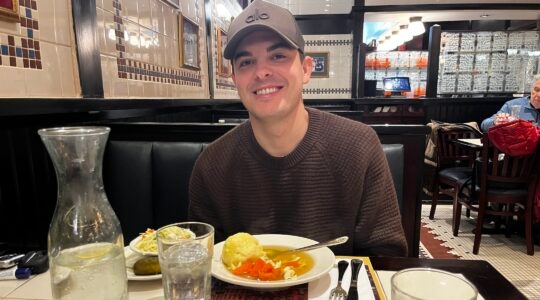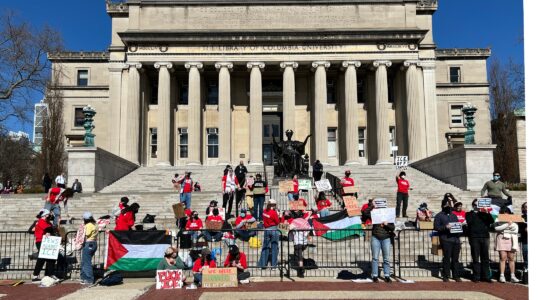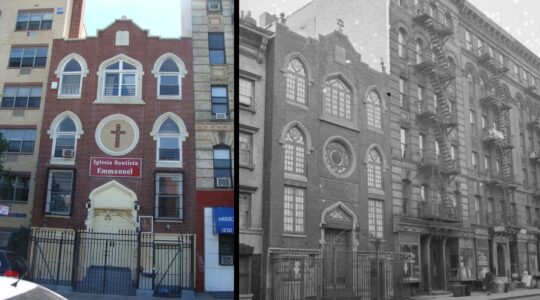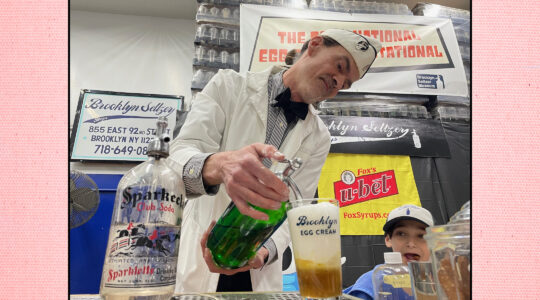As Jews struggle with the high cost of observance — from pricey High Holy Days seats to steadily climbing day-school tuitions — now comes word that lulavs and etrogs, the staples of Sukkot, may be continuing their inflationary spiral of recent years.A complaint has been filed with the anti-monopoly division of Israel’s Ministry of Trade, charging an Arab and Jewish cartel has been buying up most of the lulav fields in El Arish, Egypt — one of the largest sources for the palm branches necessary for Sukkot, which starts tonight. Additionally, the cartel is said to control the market for haddasim,or myrtle branches, that, together with willows, are bound alongside the lulav.A similar complaint was filed last year before a compromise was reached that capped the prices for non-premium lulavs. In Israel, the lulav, etrog, willow and myrtles are sold separately, whereas in the United States they are usually sold as a set.
The haredi weekly Deiah Ve’Dibur reported that this year lulavs will be sold to wholesalers at a starting price of 15 shekels, about $3.50, instead of the old prices of three to four shekels, which is less than a dollar. Certain premium lulavs, not exported to the U.S., were selling at 200 shekels, or $47.In response to the alleged cartel’s high prices, a rabbinical court in Bnei Brak, according to the weekly, ruled that “Since the price of [fine] lulavim has risen way above justification, we therefore request that [at retail] no individual pay more than 60 shekels [$14]. … If there are dealers who have already obligated themselves and are likely to suffer a loss, people are allowed to pay them for the most [premium lulavs] 100 shekels [$23.50], not more.”Dealers estimate that more than 175,000 lulav-etrog sets are sold in the U.S. In New York, where some dealers claim to sell more than 20,000 in the four days between Yom Kippur and Sukkot — enough to earn the dealer a full year’s salary — prices for lulav-etrog sets ranged from $35-$100 at Esrogim ‘C’ Us, with four outlets in Brooklyn and Long Island. At Schwartzman Esrogim U.S.A., in Brooklyn, prices ranged from $45-$125, with similar prices at Esrog Warehouse in Queens.Typical of the inflated 1999 prices, at Riverdale Judaica in the Bronx, which is selling lulav-etrog sets for the Riverdale Jewish Center, prices jumped from 1998’s $38, $55 and $75 to $45, $65 and $85.However, Oorah’s Kiruv Rechokim, in Lakewood, N.J., was asking just $18 to cover the cost of giving a kosher lulav and etrog to families being “introduced” to the mitzvah.Most American lulavs come from the same El Arish fields charged with being run by a cartel. The fields, near Gaza, are the only ones Israel allows for import. Israel’s agricultural ministry has banned lulavs from Jordan and elsewhere, as they are said to be potentially contaminated with insects that could threaten Israel’s own date-palms. American lulavs also are grown in California and Arizona.There is an importing problem in the U.S., as well. American Jews coming back from Canada — or Canadian Jews visiting friends or relatives here — could face big problems bringing the ritual materials for Sukkot across the border.For the second year in a row, Agudath Israel of America, the fervently Orthodox umbrella group, has intervened with the U.S. Department of Agriculture in an effort to smooth out the Sukkot wrinkles. The problem is U.S. agricultural laws designed to protect American farms from the scourge of the Mediterranean fruit fly.
In the past, Jewish travelers coming to this country from Canada — or Canadians arriving here for the holidays, etrogs in hand — often found themselves confronted by customs inspectors who seemed to think the fruit was a menace to the nation.Last year, working with Agriculture Secretary Dan Glickman, Agudah worked out a compromise that allowed etrogs to come across the border during the holiday period, as long as they carried a certificate from the Israeli government certifying their bug-free status.But it didn’t exactly work the way Agudah’s Abba Cohen hoped. “It wasn’t easy for people to have the proper documentation,” he said. “So there were still confiscations.”In recent months Cohen and agriculture officials created a plan in which travelers to Canada can get their lulav-etrog sets certified by agriculture inspectors before they leave so they can return without hassle. Washington Correspondent James D. Besser contributed to this report
The New York Jewish Week brings you the stories behind the headlines, keeping you connected to Jewish life in New York. Help sustain the reporting you trust by donating today.




